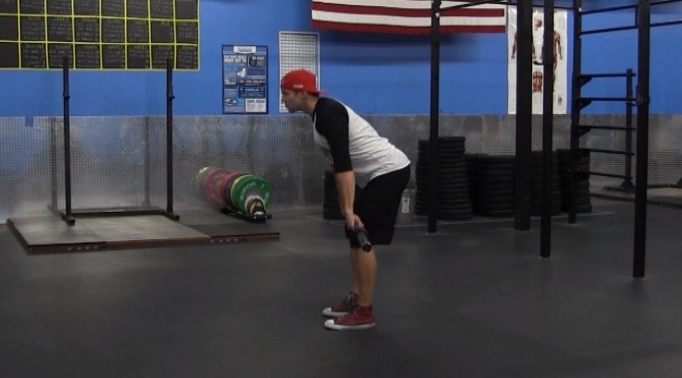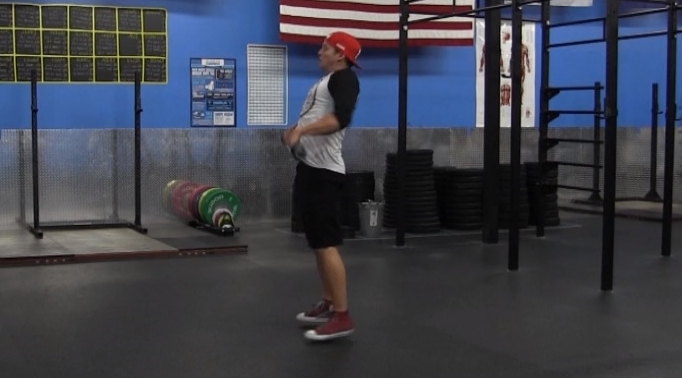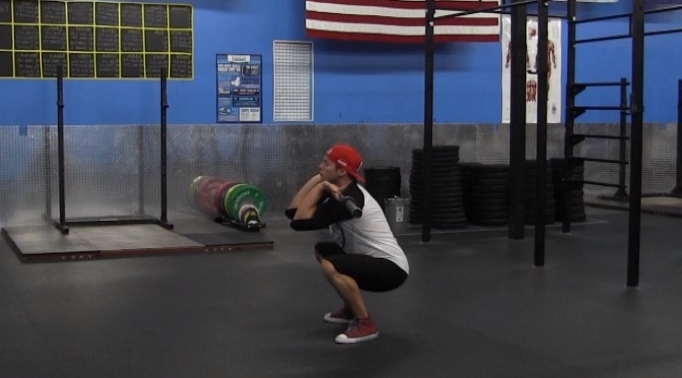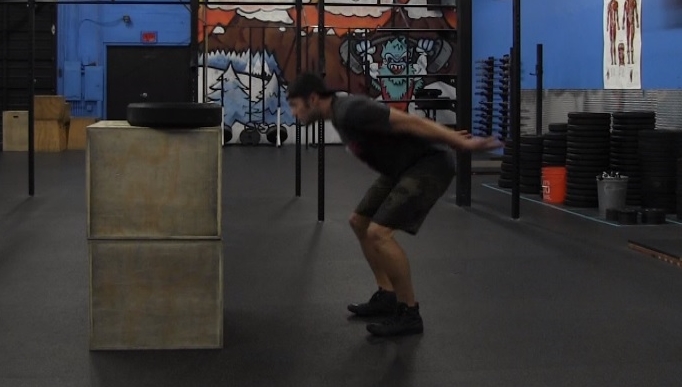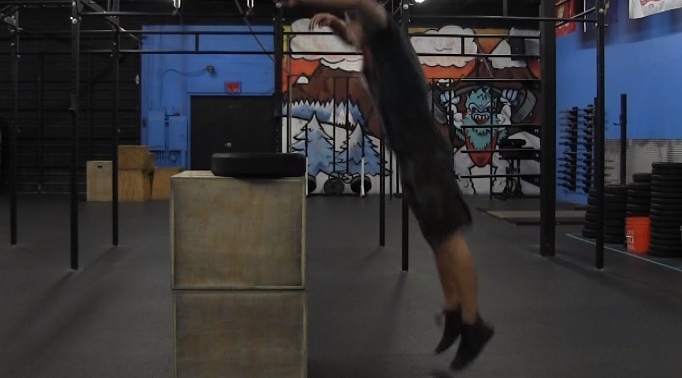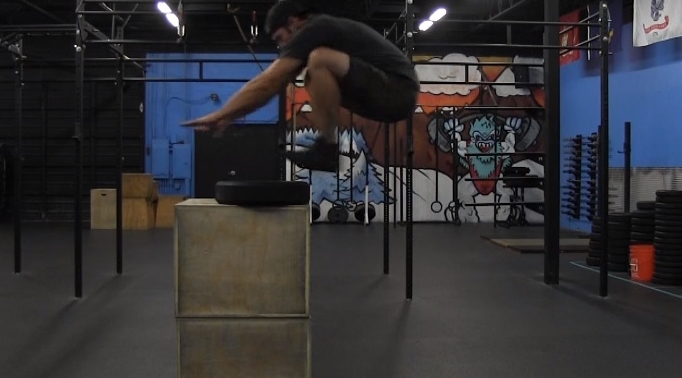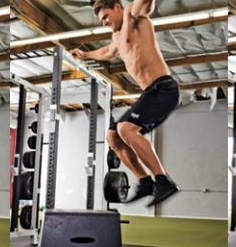... Said No Educated Coach, Ever.
When an athlete performs a Box Jump for Max Height, films it, and posts it to the "internets", you can always expect an "online coach" to chime-in (see: "CHIME-IN COACH" Article") with; "High box jumps are just great hip mobility, that's all!"
Uh, Thanks....
I've seen this statement, myself, several hundred times. What's weird is how these "coaches" never seem to bring up their thoughts on the matter, face to face. They hide behind their keyboards, and say whatever silly nonsense they want to say.
Seriously, I'd love to educate them on the subject in person, instead of argue with them online. Problem is; I don't have enough time in my schedule to educate every person who makes such an anecdotal statement. Plus, the likelihood of them actually absorbing the information and applying it themselves, is about as likely as F45 athletes actually beating Rich Froning or Ben Smith in the F45 World Series.
So, I'll reply with simply the word; "FALSE." Roughly, 99% of the time. Could I provide a longer reply? YES. Why don't I? There's already a ton of empirical evidence out there that proves such an uneducated statement to be false. All they have to do is; research it.
Word to the wise: "STOP READING SILLY MAGAZINE ARTICLES AND BLOGS THAT ARE RARELY BACKED BY EMPIRICAL EVIDENCE OR PEER REVIEWED." Unless you believe everything on the internet and in magazines is always 100% true, then in that case; ignorance is bliss. As fitness professionals, coaches, and knowledge yearning students it's important to remember that the fitness industry has a whole-lot-a: "Bro Reviewed, Just-Trust-Me, Hearsay Bologna". So the next time Billy-McChime-In decides to put on his "online coach" hat, drop him the link to this article.
----- ENOUGH RANTING AND SOAP-BOXING -----
QUESTION: What do we see when an athlete performs a freakishly high box jump?
They jump, and their knees go outside their shoulders and up to their ears as if they were a frog that was compacted into a tight wound up ball. In other words; what we see occurring (on a superficial level): Flexibility, Coordination, Balance (landing position), Mobility, and even Agility & Accuracy. Does this mean those "online-chime-in-coaches" are wrong when they say; "Box jump's are only great hip mobility"? Answer: YES & NO.
WHY ARE THEY RIGHT AND WRONG?
Does it take mobility to do a high box jump? YES. Is it the sole key factor involved with high box jumps? NO. To say: "High box jumps are only great hip mobility" is to say that a contortionist should have ZERO problem doing a standing 50" box jump. Likewise that a powerlifter only needs great hip mobility to squat 700lbs. Any educated coach can look at a high box jump and recognize several other (more important) key components. All of which are staples for raw & real athleticism.
SPEED, POWER & STRENGTH
Most will agree with speed and power, some will question strength, and in order to guarantee that few will miss the entire point (sorry, not everyone is comfortable outside their own bubble) here are the definitions of all 3 from the NSCA:
Speed - Movement distance per unit of time. #2 (BAECHEL, 2008)
Power - Time rate of doing work. Work/Time. #2 (BAECHEL, 2008)
Strength - The maximal force that a muscle or muscle groups can generate at a specified velocity. #3 (BAECHEL,2008) .
Here are some more via the CrossFit Journal in 2002...
Speed - The ability to minimize the time cycle of a repeated movement. #1 (GLASSMAN, 2002)
Power- The ability of a muscular unit, or combination of units, to apply maximum force in minimum time. #1 (GLASSMAN, 2002)
Strength - The ability of a muscular unit, or combination of muscular units, to apply force. #1 (GLASSMAN, 2002)
All of these key factors occur during a high box jump. When we jump, we are applying force, very quickly, and with very little resistance.
HOW DO WE KNOW THIS?
Dr. Charlie A Hicks-Little, runs the " Sports Medicine Research Laboratory" at the University of Utah. The lab has some of the most incredible motion capture equipment and force plate equipment I have ever seen. She also just happens to be one of the best in the world at what she does, and she is keen to determining what happens during human motion in space. I have had the opportunity to work with her multiple times, and I am grateful she allowed me into her lab to study what occurs when I box jump at varying heights. The goal was to determine; whether or not the box jump is a significant movement or if it's simply a parlor trick backed up with smoke and mirrors.
For those of you who enjoy "Magic Tricks", I apologize in advance. There are no smoke and mirrors, there are no tricks, just real science and no science fiction.
When asked to perform a 24" Box Jump with as little effort as possible, I was able to produce ~382lbs of force in a fraction of a second during take-off. At the time, this meant I was producing 2X my body weight (191.3lbs) in force and very quickly. As the height of the box increased, so did the amount of force I produced. Which in turn, far surpassed my best standing vertical leap (44"), measuring at ~400+lbs of force. Box Jumps that were 60+" I was able to produce ~600+lbs of force. Mobility and Flexibility aside, that's a CRAP TON of force from a mere body weight movement! Even more so for a jump!
AREN'T BOX JUMPS FOR CONDITIONING? THEY DON'T HAVE ANY TRANSFER SKILL POTENTIAL! RIGHT?
False.
Try this; 1. Stand upright and perform a clean with an imaginary bar. 2. Now, perform a box jump onto an imaginary box, the imaginary height is not relative (don't take this too seriously). 3. Now, perform them both again, and pay close attention to your hip mechanics.
Notice a movement pattern? Now consider how many movements in fitness, sport and life mimic that pattern. Expand that list even further and consider how many movements require use of the hips. Do you see where I am taking this? Everything we do requires hip efficiency & power, and at an even higher level in sport and fitness. What is beautiful about the box jump, especially box jumps for height, is how it trains our hips & Central Nervous System (CNS) for a higher level of efficiency and power. And not just for jumping on a box, but for so many aspects of fitness, sport and life.
STILL, YOU CAN HAVE GREAT MOBILITY AND "SO-SO" POWER AND STILL JUMP ONTO A HIGH BOX! RIGht?
Yes, you can. Unfortunately that's only the tip of the iceberg for an athlete. If the athlete doesn't learn how to increase their power and strength, they are unbalanced and missing out on great explosive potential.
FOR EXAMPLE:
ATHLETE 1 - Is a Supple Leopard and Method of SMR guru, Movement Fix stud, and Flexibility RX king! In other words, he has great mobility and flexibility. He also has a 50" standing box jump, with a lower level of max force. So he has lots of mobility and a decent amount of power.
ATHLETE 2 - Has decent mobility, but is struggling to tuck his knees into position, and has limited range of motion once in that position (meaning he cannot tighten up his tuck). He still produces 100lbs MORE force than Athlete 1 at the same height of 50".
ATHLETE 3 - Great hip mobility & great amount of force being generated. With a 60" box jump! Athletes 1 & 2 are left wanting.
If we could mesh the best qualities of Athlete 1 (expert level mobility) with the best qualities of Athlete 2 (high max force), we could produce similar results to that of Athlete 3.
Point is; you need both (mobility and powerful max force production) to go higher. You can be great at one and decent at the other, but progress requires improving your weaknesses.
HERE'S ANOTHER WAY TO LOOK AT IT:
Take Athlete 1 and Athlete 2 from the previous example. Athlete 1 has incredible mobility and decent power. Athlete 2 has great power and decent mobility. Question #1: Who jumps higher, if they are both jumping onto a 24" box? Question #2: Which athlete has the most potential to progress?
ATHLETE 1 ATHLETE 2
Answer #1: Athlete 2. Why though? Athlete 2 has not maxed out their mobility/flexibility in the jump. Athlete 1 is maxed out/ near maxed out on their mobility/flexibility.
Answer #2: Whoever continues to improve their weaknesses and their strengths. How So? If Athlete 1 develops more power and strength, they can go higher. If Athlete 2 develops more mobility/flexiblity, they can go higher. You're only as #Explosive as your weakest link.
MYTH: "BOX JUMPING FOR HEIGHT IS ONLY GREAT HIP MOBILITY"
RESULTS: "MYTH DEBUNKED"
- COACH MOODY
>> WANT MORE EXPLOSIVE POWER & SPEED? SUPPLEMENT YOUR TRAINING WITH THEXWOD.com/FITNESS <<
1) Glassman, G. (2002). CrossFit Journal. What Is Fitness?, 4-4. Retrieved August 16, 2015, from http://library.crossfit.com/free/pdf/CFJ-trial.pdf
2) Harman, E. (2008). Biomechanics of Resistance Exercise. In T. Baechle & R. Earle (Eds.), NSCA's essentials of personal training (3rd ed.). Champaign, IL: Human Kinetics.
3) Harman, E., & Garhammer, J. (2008). Administration, Scoring, and Interpretation of Selected Tests. In T. Baechle & R. Earle (Eds.), NSCA's essentials of personal training (3rd ed.). Champaign, IL: Human Kinetics.





